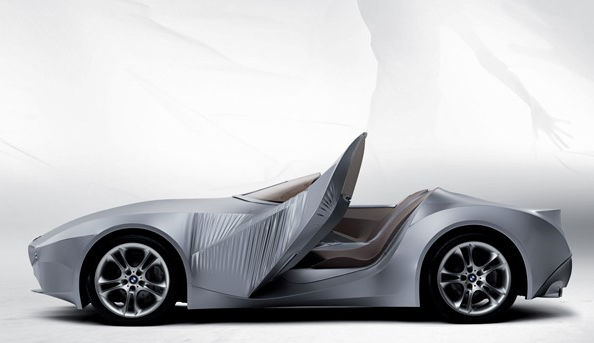The technical body of the 21st century is not rounded, its flesh is not made of flesh, its tendons are not tendons – and when it stretches and flexes its muscles, no blood is pumped through its veins, but hydraulic fluid. It is tense as though coiled up and it has clear contours which become visible through its shimmering skin as razor-sharp edges and bends. Its skeleton consists of a stable space frame and when its doors open, its dress has folds like the Pont Neuf in Paris when Christo wrapped it. Its head is covered with hard ridges, as though a mountain range suddenly sprang up from a plain. And the face of this hybrid figure bears the concise features of the men of the future as Futurism once depicted them.
The world has never before seen anything like the BMW “GINA Light” Visionary Model. It is a car whose bodywork is no longer made of metal, but whose body is surrounded by a closefitting dress made of high-tech fabric, as though the profession of bodywork tailor were an invention of the future and really all the rage. BMW Group Design has, under the direction of Chris Bangle, truly launched a revolution. The vision for the car of the future has taken concrete form in a two-seater Roadster with all the proportions characteristic of the marque.
The design of the GINA Light (GINA stands for “Geometry and Functions in ‘N’ Adaptations”) which takes a sculptural form even today and consists of taut and twisted surfaces, is consistently developed further. The front and side sections form a flowing unity both materially and optically. Joints are a thing of the past – and when the doors swing upwards, the dress, which is stable in form and made of water-repellant hybrid fabric resistant to both cold and heat, forms distinct creases.
The designers questioned all previous ideas about the design of a vehicle body and the materials used to make it. A variable structure has replaced elements which are usually fixed such as the front apron, grill, headlamps, hood, fenders, doors, wheel arches and trunk. An extremely hardwearing special fabric is stretched over this metal structure. Individual elements of the substructure are arranged to be flexible; they are able to change their position as required, controlled either electrically or electrohydraulically, and can not only give the “skin” a new form, but also the driver new functions. The most concise examples of this are the headlamps which are hidden in a crease and the infinitely variable contour of the fenders, which sometimes goes up, sometimes comes down and thus can be adjusted to the appropriate driving situation.
Does a car’s skin always have to be made of metal? This was BMW Chief Designer Chris Bangle’s question. For crash behavior, stability of the body and other parts of the structural base we have long been able to do without it. If we understand that properly, completely new possibilities open up to us, especially as the material which is used is no longer bound to fulfilling a particular function or taking on a predefined form. “In short,” says Bangle, “the GINA philosophy is flexibility. Think flexibly and act flexibly.” Or, as he puts it: “Context over dogma, that’s it!”
The result: The vehicle adapts to different requirements. Depending on the desired aerodynamic resistance, the fenders are sometimes flat, sometimes drawn up like shoulders. Sometimes a spoiler rises up over the trunk like the taut muscles of a tiger about to pounce. However, with the GINA Light it is not only some kind of material “morphs” which are finding their way into car design, i.e., a mixture of superimposition and transformation. Also, with this super-trailblazing design, we are seeing the return of our fascination with a lasting formal transformation, as propagated by Futurism in its obsession with speed in the early 20th century – right down to the “deification of lasting change.”
If we consider this approach from the viewpoint of art history, we believe that the designers have tried to merge the hardness and precision of a Futuristic sculpture by Umberto Boccioni, which decidedly makes a statement, with the curlicues of the Baroque and use a powerful eight-cylinder to get it moving. This has led to the creation of a fascinating technical Futurism, which sees the fusion of an airship with a muscleman, a dead machine with a bit of breathing flesh. We can do nothing but marvel at it; the new hybrid vehicle of a future in which technology, biology and fashion make common cause. The future of automobile design has rebegun with GINA. “A roaring car that seems to ride on grapeshot,” declared Marinetti in 1909, “is more beautiful than the Victory of Samothrace.” When GINA, the new goddess, suddenly opens her eyes and winks at us, then we would almost like to believe the new Animism and say, “She’s alive!”











